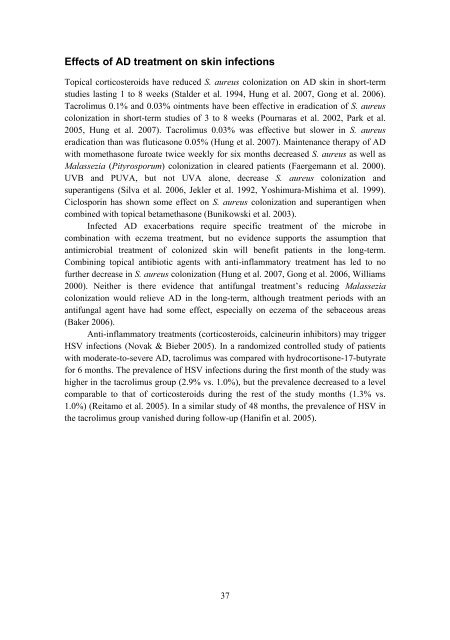Topical tacrolimus in atopic dermatitis: Effects of ... - Helda - Helsinki.fi
Topical tacrolimus in atopic dermatitis: Effects of ... - Helda - Helsinki.fi
Topical tacrolimus in atopic dermatitis: Effects of ... - Helda - Helsinki.fi
You also want an ePaper? Increase the reach of your titles
YUMPU automatically turns print PDFs into web optimized ePapers that Google loves.
<strong>Effects</strong> <strong>of</strong> AD treatment on sk<strong>in</strong> <strong>in</strong>fections<br />
<strong>Topical</strong> corticosteroids have reduced S. aureus colonization on AD sk<strong>in</strong> <strong>in</strong> short-term<br />
studies last<strong>in</strong>g 1 to 8 weeks (Stalder et al. 1994, Hung et al. 2007, Gong et al. 2006).<br />
Tacrolimus 0.1% and 0.03% o<strong>in</strong>tments have been effective <strong>in</strong> eradication <strong>of</strong> S. aureus<br />
colonization <strong>in</strong> short-term studies <strong>of</strong> 3 to 8 weeks (Pournaras et al. 2002, Park et al.<br />
2005, Hung et al. 2007). Tacrolimus 0.03% was effective but slower <strong>in</strong> S. aureus<br />
eradication than was fluticasone 0.05% (Hung et al. 2007). Ma<strong>in</strong>tenance therapy <strong>of</strong> AD<br />
with momethasone furoate twice weekly for six months decreased S. aureus as well as<br />
Malassezia (Pityrosporum) colonization <strong>in</strong> cleared patients (Faergemann et al. 2000).<br />
UVB and PUVA, but not UVA alone, decrease S. aureus colonization and<br />
superantigens (Silva et al. 2006, Jekler et al. 1992, Yoshimura-Mishima et al. 1999).<br />
Ciclospor<strong>in</strong> has shown some effect on S. aureus colonization and superantigen when<br />
comb<strong>in</strong>ed with topical betamethasone (Bunikowski et al. 2003).<br />
Infected AD exacerbations require speci<strong>fi</strong>c treatment <strong>of</strong> the microbe <strong>in</strong><br />
comb<strong>in</strong>ation with eczema treatment, but no evidence supports the assumption that<br />
antimicrobial treatment <strong>of</strong> colonized sk<strong>in</strong> will bene<strong>fi</strong>t patients <strong>in</strong> the long-term.<br />
Comb<strong>in</strong><strong>in</strong>g topical antibiotic agents with anti-<strong>in</strong>flammatory treatment has led to no<br />
further decrease <strong>in</strong> S. aureus colonization (Hung et al. 2007, Gong et al. 2006, Williams<br />
2000). Neither is there evidence that antifungal treatment’s reduc<strong>in</strong>g Malassezia<br />
colonization would relieve AD <strong>in</strong> the long-term, although treatment periods with an<br />
antifungal agent have had some effect, especially on eczema <strong>of</strong> the sebaceous areas<br />
(Baker 2006).<br />
Anti-<strong>in</strong>flammatory treatments (corticosteroids, calc<strong>in</strong>eur<strong>in</strong> <strong>in</strong>hibitors) may trigger<br />
HSV <strong>in</strong>fections (Novak & Bieber 2005). In a randomized controlled study <strong>of</strong> patients<br />
with moderate-to-severe AD, <strong>tacrolimus</strong> was compared with hydrocortisone-17-butyrate<br />
for 6 months. The prevalence <strong>of</strong> HSV <strong>in</strong>fections dur<strong>in</strong>g the <strong>fi</strong>rst month <strong>of</strong> the study was<br />
higher <strong>in</strong> the <strong>tacrolimus</strong> group (2.9% vs. 1.0%), but the prevalence decreased to a level<br />
comparable to that <strong>of</strong> corticosteroids dur<strong>in</strong>g the rest <strong>of</strong> the study months (1.3% vs.<br />
1.0%) (Reitamo et al. 2005). In a similar study <strong>of</strong> 48 months, the prevalence <strong>of</strong> HSV <strong>in</strong><br />
the <strong>tacrolimus</strong> group vanished dur<strong>in</strong>g follow-up (Hanif<strong>in</strong> et al. 2005).<br />
37

















